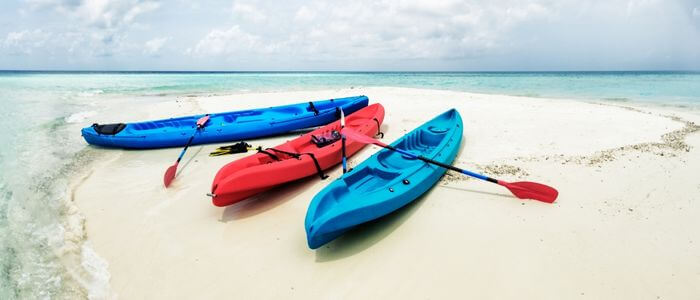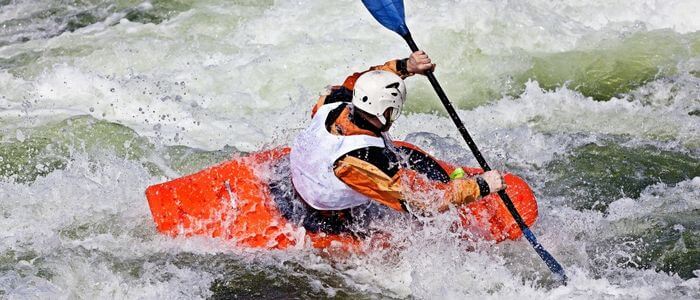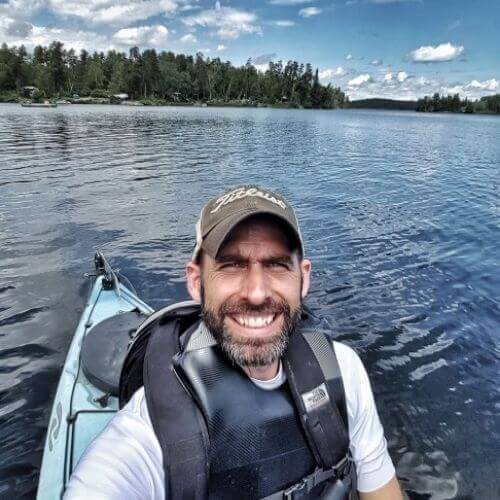
If you’re thinking about going kayaking in the near future, you’re probably wondering what size Kayak you should buy. If you’re looking to buy a kayak and plan on using it, you’ll want to choose one that fits you, your weight, and your paddling style. You may have heard that a 10ft kayak is ideal for most people, but if you’re a heavier individual or like to kayak with a lot of gear, then a larger kayak will be better for you. You’ll find our suggested kayak weight limit guides below.
The weight for kayaking varies from person to person and also depends upon the type of Kayak and the outfield of water. Normally recommended weight for a better kayaking experience is 20-30% less than the total capacity of the Kayak. If the manufacturers have mentioned the weight of 200 pounds, for a better and safe kayaking experience, it must be curtailed to at least 140-160 pounds.
Kayaks are a great way to enjoy the outdoors, but before you head out on your next adventure, it’s important to know the weight limit of your Kayak. Most kayaks have a weight limit between 250 and 500 pounds or 110-220 kilograms, but it’s always best to check the manufacturer’s specifications to be sure.
Keep in mind that the weight limit includes not only the kayaker’s weight but also any gear or supplies being carried. Kayak weight limit: Picking a kayak that is right for you is not an easy task, but there are a few things you can do to help make sure you get the right Kayak for your size and intended use.

Many kayaks have a weight limit, which is the maximum weight the Kayak can hold. The manufacturers mention the maximum weight capacity for the particular Kayak. This maximum capacity is generally curtailed by 30%.
If the maximum weight limit for a kayak is mentioned as 100 kilograms (for example), then the ideal kayaking would be 70 kilograms after applying the curtailment formula for Kayak, which is 30%. This is usually printed on a sticker on the Kayak.
You can also find the weight limit in the Kayak’s specifications, which are usually available online. The weight limit is important because it determines how much the Kayak can safely hold.
There are many factors that go into deciding what your Kayak’s weight limit should be.
Just because a kayak says it can hold 180 kilograms or 400 lbs. doesn’t mean you should load it to the maximum.
Doing so could potentially make your Kayak less stable in different weather conditions. So, while it may seem common sense not to overfill your Kayak, there are some specific guidelines you can follow to ensure you’re not exceeding the recommended weight limit for optimal performance.
For optimal kayak performance, you can use 80% of the actual weight mentioned by the manufacturers, leaving 20% for optimal performance.
For example, the Kayak is designed for 500 pounds, and you can use 400 max along with your body weight, gears, and accessories.
Touring kayaks are designed to hold more weight and gear than other kayak types. They’re for long-distance trips on flat water, like lakes and slow-moving rivers. They’re usually longer and narrower than recreational kayaks, which makes them faster but less stable. Most touring kayaks can hold up to 300 to 400 lbs. of weight, which is great for carrying gear, a cooler, and even a camping setup.
A fishing kayak is a kayak designed for fishing. They are usually designed with features that make them more stable and easier to fish from than a regular kayak. Fishing kayaks are usually between 10 and 16 feet long and have one or two seats.
Some fishing kayaks have pedaling systems that allow you to move around while fishing. A fishing kayak’s size and the weight capacity is an important consideration when choosing one. Fishing kayaks hold up to 275 to 550 lbs, which is plenty of weight for most anglers and their gear.
Recreational kayaks are designed for the casual paddler who wants to get out on the water for a leisurely paddle. They are stable and easy to maneuver, making them a good choice for beginners or those who don’t want to deal with the challenges of a more difficult kayak.
Recreational kayaks are also a good choice for those who want to fish or camp from their Kayak, as they often have ample storage space for gear. Most recreational kayaks are between 10 and 12 feet long and hold up to 250 to 350 pounds.
Inflatable kayaks are a great way to get out on the water, whether paddling on a lake, river, or ocean. They’re also incredibly versatile, with some models designed for solo paddling and others that can accommodate two or more people. And, because they’re inflatable, they’re much easier to transport and store than traditional hard-shell kayaks.
But how much weight can an inflatable kayak hold? The answer is that it depends on the Kayak. Most inflatable kayaks have a weight capacity of between 225 and 855 pounds. That means they can accommodate one or two people plus any gear you might need for your paddling adventure.
The paddle sport of kayaking is enjoyed by many for being an easy sport to get into. It’s something that families can also enjoy with parents and children all in the same vessel. However, not all kayaks are made equal.
Tandem kayaks can hold a higher weight capacity than solo kayaks, such as the Ocean Kayak Prowler Big Game II tandem kayak. Tandem kayaks can hold up to 425 to 700 lbs. This makes tandem kayaks suitable for people heavier than the average or for families. Listed below are some of the other
When your weight slightly exceeds the recommended amount, you may experience certain health problems. “Can you have only a little bit more weight in the boat than recommended?” It’s a good question. Many people are pushing their boats to the limits when loading them with heavy gear and supplies. This can affect handling, performance, and safety. We’ll explore the reasons behind this concern and what to do about it.
The weight of a single kayak is relatively light, but when the cumulative total weight exceeds the capacity of the Kayak, it will cause many problems for you.
Therefore, when carrying kayaks, you need to know about the weight of the Kayak. Kayak companies that sell kayaks for fishing often mention how light the Kayak is. But can you imagine what happens when a kayak’s weight slightly exceeds its specifications?
How to choose the best performance kayak for your needs. A few things to consider when purchasing a performance kayak, such as what type of kayaking you will be doing and what features are important to you.
Choosing a comfortable kayak that fits your specific needs is important to get the most out of your kayaking experience. In this article, we will go over tips on choosing the best performance kayak for your needs.
The performance kayak is a great addition to the family of kayaks. With the performance kayak, you can row faster and tour longer. The performance kayak has been designed for people who want to use it for fishing, racing, and touring. Whether you want to go fishing or for fun and relaxation, the performance kayak will be a useful addition to your gear.
How much weight is safe for kayaking? There is no rule of thumb for a kayak’s weight limit guide. However, you can figure out whether this Kayak is safer for you. All you have to manage the total weight (your body weight + all your gears) must be 30% less than the total weighing capacity of your Kayak.
Kayaking is a great option for those who want to enjoy the water while getting a bit of exercise, but knowing how much weight is safe for kayaking before getting started is important.
This definitive guide will tell you everything you need to know about how much weight is safe for kayaking so that you can enjoy your time on the water without worry.
There are a few things to consider when determining what size kayak you need. One of the most important factors is the weight limit. You don’t want to get a kayak that can’t hold your weight or all your gear. Another factor to consider is length and width.
A longer and wider kayak will be more stable in the water but may be harder to maneuver. Consider where you’ll be using your Kayak most when making your decision. Stability should be your main concern if you’re mostly paddling on rivers or in calmer waters.
It is important to understand the relationship between the size of a kayak and its weight. The smaller the Kayak, the lighter it is, which makes it easier to carry around.
Some kayaks are constructed in such a way that the weight of the Kayak is evenly distributed. This ensures that the Kayak doesn’t tip over in the water.
The size of the Kayak also affects its speed, maneuverability, and how far one can travel using it.
A kayak is a small boat specially designed to help the user feel relaxed and peaceful while paddling the boat in the water. A kayak comprises a few parts, each of which has its own importance.
The size of the Kayak is one of the most important parts. Different sizes are made for different reasons. According to the top ten kayak reviews, the correct size of the Kayak should be 5-6 ft or 2 meters.
When it comes to kayaks, size does matter. The length and width of your Kayak can significantly impact its speed, maneuverability, and comfort – so choosing the right size is crucial for having a great time out on the water.
Here’s a quick guide to help you select the perfect-sized Kayak for your next adventure: Speed: If you’re looking for a fast ride, longer and narrower kayaks are typically the way to go.
Hydrodynamics studies the resistance of fluids to objects moving through them. More specifically, it is the study of fluid flow around solid objects.
Regarding kayaking, several factors determine how fast, maneuverable, and comfortable a kayak is. One of the most important factors is the Kayak’s weight, which affects other factors like speed, maneuverability, and comfort.
People have different preferences for the size of their kayaks based on their desired use. Some kayakers might want a smaller, more maneuverable kayak for racing, while others might prefer a larger kayak with more storage space for extended trips.
Ultimately, the best way to figure out what size kayak you need is to consider how you intend to use it and find a model that fits your specifications. Kayaks come in different sizes and shapes but the main difference will be its size.
This is something that is a very personal preference for different users. Different people have different preferences for the size of the kayak. If you’re unsure about what size Kayak you need, our team at Outdoor play can help guide you to the perfect fit.
Different kayaks have different weight limits, so choosing a kayak that can accommodate your weight is important. Some kayaks are designed for one person, while others accommodate multiple people. There are also kayaks with different features and benefits, so it’s important to read reviews before choosing the right one.
They have been used for both leisure and fishing purposes. For someone who wants to get into kayaking, the first thing to do is decide on the kind of Kayak you want. This will depend on the number of people sharing the Kayak, the kind of experience you are after, and the purpose you want to use it.
When planning a kayaking trip, deciding what you need to bring and what would be nice to have is important. Make a list of the must-haves and the nice-to-haves. Find a kayak that fits your needs.
Some must-haves for a kayaking trip are a life jacket, sunscreen, insect repellent, water, snacks, and a first aid kit. Nice-to-haves might include binoculars, a camera, fishing gear, and a map.
There are many different types of kayaks available on the market. Finding one that fits your needs in size, weight, and storage capacity are important. Look for a kayak that is comfortable and easy to maneuver.
When choosing the right accessories for your budget, it is important to consider a few factors. First, you must decide what type of accessory you are looking for. Second, you need to find a balance between quality and price. Lastly, you should ensure that the accessory you choose is the right size for your needs.
This is what we believe is the best Kayak for your needs, and the kayak size depends on how many people you will take if you are one person. The kayak size should be between 10-15ft. If you are two people, the kayak size is between 12-18ft. If you are three people, the kayak size is between 16-20ft.
Weight capacities vary with every design of Kayak. If you want to buy a kayak, you should read the kayak weight capacity and height of the kayaker. Choosing a kayak is a matter of personal choice. It depends on the kayaker’s size and weight. The Kayak’s weight capacity is usually printed on the hull. The right Kayak size will help you paddle easily and more efficiently.

Hey there kayak lovers! I’m Jay Schwartz, the author here at Kayak Guidance! You know water sports – you know me! My life is all about it. Kayaking, Paddleboarding, Fishing, Snorkeling and so much more. I love to share my passion and knowledge with all of you.

Hey there kayak lovers! I’m Jay Schwartz, the author here at Kayak Guidance! You know water sports – you know me! My life is all about it. Kayaking, Paddleboarding, Fishing, Snorkeling and so much more. I love to share my passion and knowledge with all of you.

Welcome to KayakGuidance.com! If you’re looking to have some fun outdoor water adventures, then you have come to the right place. We help our readers find the best kayaks and water related equipment to help you have the best time of your life whenever you are engaging in water activities.
This site is a participant in the Amazon services LLC associates program, an affiliate advertising program designed to provide a means for sites to earn advertising fees by advertising and linking to Amazon.com.